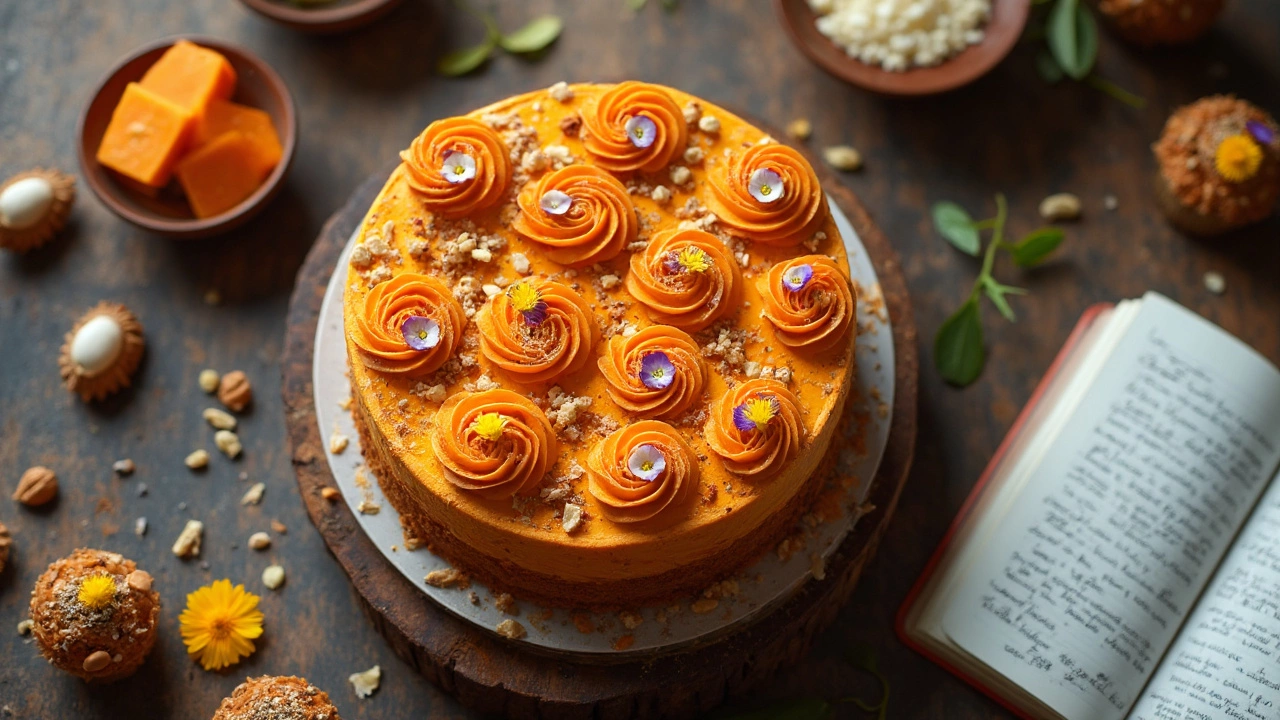Sweet potato isn’t just safe for gluten-free diets—it’s actually a rockstar ingredient for baking. If you have celiac disease, non-celiac gluten sensitivity, or just want to steer clear of gluten, you can use sweet potato without stressing. There’s zero gluten lurking in plain sweet potatoes because gluten comes from certain grains, not veggies like these.
People are baking with sweet potato for more than just the peace of mind. It adds natural sweetness, keeps cakes moist, and sneaks in a serving of veggies (goodbye, dry, crumbly gluten-free disasters!). You can mash it, puree it, or even shred it and toss it right into your gluten-free cake batter. Some bakers even swap out part of the flour for cooked sweet potato to get a soft, almost fudgy texture that everyone raves about. So yes, it’s gluten-free—and it makes your cakes taste and feel better, too.
- What Makes Sweet Potato Gluten-Free
- Why Sweet Potato Works in Gluten-Free Cakes
- How to Use Sweet Potato in Baking
- Hidden Gluten: Store-Bought Sweet Potato Traps
- Sweet Potato Recipe Ideas and Baking Tips
What Makes Sweet Potato Gluten-Free
Here’s the deal: sweet potato doesn’t come close to gluten. Gluten is a protein you’ll only find in certain grains—think wheat, barley, and rye. Sweet potato is a root vegetable, so it’s in a completely different food group. That’s why you never have to worry about it naturally containing gluten.
Fresh, whole sweet potatoes are naturally safe for anyone on a gluten-free diet, whether you’re baking, roasting, or pureeing them. Even if you have celiac disease, the plain veggie itself is zero risk. The confusion usually starts when sweet potatoes are packaged, canned, or processed alongside gluten products. But if you’re sticking to the real deal—whole, unprocessed sweet potato—you’re golden.
Just to break it down, here’s a quick look at where gluten hides and where it doesn’t:
- Wheat, barley, rye: Always contain gluten.
- Oats: Sometimes cross-contaminated, so check the label.
- Sweet Potato: Naturally gluten-free, no risk if whole and plain.
Need some numbers? According to recent allergy tracking surveys, about 1 in 100 people are sensitive to gluten, and those folks love sweet potatoes as a safe swap for bread or flour. So if you’re trying to avoid gluten, sweet potato is a reliable base ingredient, especially for gluten-free cakes and snacks.
Why Sweet Potato Works in Gluten-Free Cakes
When you’re baking a cake without gluten, things can get tricky. Regular flour holds cakes together because of gluten. But in gluten-free cakes, that glue is missing, so cakes often turn out dry or crumbly. That’s where sweet potato comes to the rescue. It's packed with moisture and natural starch, which help mimic the structure and softness that gluten usually provides.
Now, let’s talk about why sweet potato is more than just a replacement. It’s got a creamy texture, which makes cakes moist instead of dense or gritty. The natural sweetness lets you cut back on added sugar. Plus, it offers fiber, vitamin A, and antioxidants—so you’re sneaking in nutrition at dessert time.
- Moisture: Sweet potato puree keeps cakes soft for days. Some people say their cakes taste even better the next day.
- Binding: Its natural starches help hold things together, reducing the need for extra binders like xanthan gum or extra eggs.
- Flavor: It delivers a light sweetness that pairs well with spices like cinnamon and nutmeg. Even picky eaters usually dig the subtle taste.
- Color: Ever noticed that orange glow in carrot cake or pumpkin loaf? Sweet potato gives your gluten-free bakes a similar inviting look.
If you’re the curious type, here’s a little data from a home baking experiment: Subbing in half a cup of mashed sweet potato for a quarter of the flour in a basic gluten-free cake made the crumb softer and helped the cake last longer without drying out. Below is a quick snapshot from three batches baked over a weekend.
| Batch | Standard Gluten-Free | With Sweet Potato |
|---|---|---|
| Day 1 | Drier, crumbly | Soft, moist |
| Day 2 | Slightly stale | Still moist |
| Flavor Test | Bland | Sweet, almost caramel-like |
No food science degree required—just swap in some sweet potato and your cakes will actually taste like cake, not sawdust. That’s the real win.

How to Use Sweet Potato in Baking
Ready to make your gluten-free cakes even better? Sweet potato fits right in, but the magic’s all about how you use it. First thing, pick fresh, firm sweet potatoes without bruises. While canned sweet potato works in a pinch, fresh gives richer taste and brighter color.
Most recipes use mashed or pureed sweet potato. Baking or microwaving works better than boiling because you don’t want soggy mash. Just stab a few holes, bake at 400°F for about 45 minutes, scoop out the insides, and mash until totally smooth.
In cake batters, sweet potato replaces a chunk of flour, oil, or even eggs. It adds moisture and helps bind without any gluten needed. Here are a few ways people toss it in:
- Swap out about half the butter or oil for an equal weight of sweet potato puree in moist cakes and brownies.
- Replace up to a third of your gluten-free flour blend with mashed sweet potato—perfect for denser treats, like blondies.
- Mix in half a cup of mashed sweet potato per standard cake recipe for extra color and sweetness, then cut back a bit on the sugar.
Not sure about mix-ins? Sweet potato pairs well with cinnamon, ginger, nutmeg, and even cocoa. Bake your cake as usual, but keep an eye out—it might need a touch longer in the oven because of the extra moisture.
| Sweet Potato Form | How to Use in Baking | Best For |
|---|---|---|
| Mashed/Pureed | Mix into batter, replace butter/oil/flour | Cakes, muffins, brownies |
| Shredded | Stir directly into batter | Quick breads, carrot cake-style bakes |
| Cubed | Fold in for texture | Breakfast cakes, rustic loaves |
If you're using sweet potato for the first time, test with a small batch and note the texture. Some bakers freeze sweet potato puree in cubes so it’s ready for quick cake projects. This one swap can make your gluten-free baking taste less "gluten-free" in the best possible way.
Hidden Gluten: Store-Bought Sweet Potato Traps
Just because sweet potato is naturally gluten-free doesn’t mean all sweet potato products are safe. This catches a ton of people off guard—especially if you’re eyeing that ready-made mashed sweet potato or the frozen fries. Here’s where gluten likes to sneak in:
- Pre-packaged sweet potato cakes or pies: These usually contain wheat flour (aka, major gluten problem). Always check the ingredient list even if it says “gluten-free” on the front.
- Frozen sweet potato fries: Some brands dust their fries with wheat flour for extra crunch. “Crispy” often comes at a gluten cost, so you’ve got to read the small print.
- Mashed or canned sweet potato blends: Companies sometimes use thickeners like wheat starch or mix in other grains.
- Seasoned, breaded, or battered sweet potato products: Anything battered is usually packed with gluten. Even spice blends could hide wheat-based anti-caking agents.
If you’re buying anything besides plain raw sweet potato, flip the package over and scan every ingredient. You want zero wheat, barley, rye, or malt. Avoid anything that just says “flour” unless it’s clearly marked as gluten-free.
| Product Type | Gluten-Free? | Common Hidden Gluten |
|---|---|---|
| Raw sweet potato | Yes | None |
| Frozen fries | Check label | Wheat flour, batter |
| Store-bought pie | Unlikely | Wheat flour in crust |
| Canned blends | Check label | Wheat starch, additives |
Sometimes, a product will even have a “may contain wheat” warning because of shared equipment. Avoid those if you’re really sensitive. Your best bet for cakes? Stick with homemade or brands that are certified gluten-free. When in doubt, simple and from-scratch is the safest route.

Sweet Potato Recipe Ideas and Baking Tips
If you’re thinking of trying sweet potato in your next gluten-free cake, you don’t have to be a pro baker. Sweet potato is super easy to work with and matches up with all sorts of flavors, from cinnamon and nutmeg to chocolate and coconut.
Here are a few tried-and-true ideas to help you get the most out of sweet potato in gluten-free baking:
- Sweet Potato Purée Cakes: Swap out half of the flour in your gluten-free cake with mashed, cooked sweet potato. You’ll get a dense, moist sponge—perfect for snack cakes and cupcakes. The flavor is sweet but mild, so it goes with almost anything.
- Sneaky Brownies: Use sweet potato purée as a base for gluten-free brownies. They get fudgy and rich without the need for extra butter or fancy gluten-free flour blends.
- Sweet Potato Pancakes: Mix grated or mashed sweet potato into pancake batter. This gives you naturally sweet, hearty pancakes packed with vitamins and fiber. Make sure to use gluten-free flour or a pre-made gluten-free pancake mix.
When adding sweet potato to baking, always cook it until soft—steamed or roasted is best—then mash or blend until smooth. The texture needs to be lump-free so your cakes come out light and even.
Here’s a basic formula for using sweet potato in gluten-free bakes:
- Cook and mash sweet potato (about 1 cup per recipe for a standard cake).
- Mix with eggs, oil, and sweetener—this works as your wet mix.
- Stir in your dry gluten-free ingredients: flour, baking powder, and seasonings.
- Bake at 350°F (175°C) and check after 25 minutes—sweet potato cakes often bake faster than traditional ones.
Here’s a quick look at the nutrition boost sweet potato brings, compared to regular cake ingredients:
| Ingredient | Fiber (g/cup) | Vitamin A (IU/cup) | Calories (per cup) |
|---|---|---|---|
| Sweet Potato (mashed) | 6.6 | 21,900 | 249 |
| All-Purpose Flour | 3.4 | 0 | 455 |
So you’re not just baking tasty treats—you’re upping the nutrition, too. Just don’t forget to check all other ingredients for hidden gluten, especially baking powder and flavored add-ins. Stick to certified gluten-free options whenever possible. Want the cake extra light? Add a bit of applesauce or banana along with the sweet potato. Looking for more rise? A splash of apple cider vinegar works wonders in gluten-free batters.